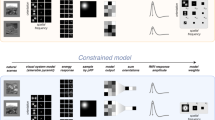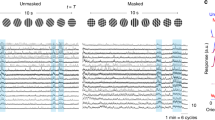Abstract
Several studies have shown that the information conveyed by bell-shaped tuning curves increases as their width decreases, leading to the notion that sharpening of tuning curves improves population codes. This notion, however, is based on assumptions that the noise distribution is independent among neurons and independent of the tuning curve width. Here we reexamine these assumptions in networks of spiking neurons by using orientation selectivity as an example. We compare two principal classes of model: one in which the tuning curves are sharpened through cortical lateral interactions, and one in which they are not. We report that sharpening through lateral interactions does not improve population codes but, on the contrary, leads to a severe loss of information. In addition, the sharpening models generate complicated codes that rely extensively on pairwise correlations. Our study generates several experimental predictions that can be used to distinguish between these two classes of model.
This is a preview of subscription content, access via your institution
Access options
Subscribe to this journal
Receive 12 print issues and online access
$209.00 per year
only $17.42 per issue
Buy this article
- Purchase on Springer Link
- Instant access to full article PDF
Prices may be subject to local taxes which are calculated during checkout





Similar content being viewed by others
References
Paradiso, M. A theory of the use of visual orientation information which exploits the columnar structure of striate cortex. Biol. Cybern. 58, 35–49 (1988).
Seung, H. & Sompolinsky, H. Simple model for reading neuronal population codes. Proc. Natl. Acad. Sci. USA 90, 10749–10753 (1993).
Somers, D.C., Nelson, S.B. & Sur, M. An emergent model of orientation selectivity in cat visual cortical simple cells. J. Neurosci. 15, 5448–5465 (1995).
Spitzer, H., Desimone, R. & Moran, J. Increased attention enhances both behavioral and neuronal performance. Science 240, 338–340 (1988).
Lee, D.K., Itti, L., Koch, C. & Braun, J. Attention activates winner-take-all competition among visual filters. Nat. Neurosci. 2, 375–381 (1999).
Murray, S.O. & Wojciulik, E. Attention increases neural selectivity in the human lateral occipital complex. Nat. Neurosci. 7, 70–74 (2004).
Schoups, A., Vogels, R., Qian, N. & Orban, G. Practising orientation identification improves orientation coding in V1 neurons. Nature 412, 549–553 (2001).
Teich, A.F. & Qian, N. Learning and adaptation in a recurrent model of V1 orientation selectivity. J. Neurophysiol. 89, 2086–2100 (2003).
Yang, T. & Maunsell, J.H. The effect of perceptual learning on neuronal responses in monkey visual area V4. J. Neurosci. 24, 1617–1626 (2004).
Fitzpatrick, D.C., Batra, R., Stanford, T.R. & Kuwada, S. A neuronal population code for sound localization. Nature 388, 871–874 (1997).
Zohary, E., Shadlen, M. & Newsome, W. Correlated neuronal discharge rate and its implication for psychophysical performance. Nature 370, 140–143 (1994).
Lee, D., Port, N.L., Kruse, W. & Georgopoulos, A.P. Variability and correlated noise in the discharge of neurons in motor and parietal areas of the primate cortex. J. Neurosci. 18, 1161–1170 (1998).
Hubel, D. & Wiesel, T. Receptive fields, binocular interaction and functional architecture in the cat's visual cortex. J. Physiol. (Lond.) 160, 106–154 (1962).
Ferster, D. & Miller, K.D. Neural mechanisms of orientation selectivity in the visual cortex. Annu. Rev. Neurosci. 23, 441–471 (2000).
Monier, C., Chavane, F., Baudot, P., Graham, L.J. & Frégnac, Y. Orientation and direction selectivity of synaptic inputs in visual cortical neurons: a diversity of combinations produces spike tuning. Neuron 37, 663–680 (2003).
Shapley, R., Hawken, M. & Ringach, D.L. Dynamics of orientation selectivity in the primary visual cortex. Neuron 38, 689–699 (2003).
Sompolinsky, H. & Shapley, R. New perspectives on the mechanisms for orientation selectivity. Curr. Opin. Neurobiol. 7, 514–522 (1997).
Ben-Yishai, R., Bar-Or, R.L. & Sompolinsky, H. Theory of orientation tuning in visual cortex. Proc. Natl. Acad. Sci. USA 92, 3844–3848 (1995).
Troyer, T.W., Krukowski, A.E., Priebe, N.J. & Miller, K.D. Contrast-invariant orientation tuning in cat visual cortex: thalamocortical input tuning and correlation-based intracortical connectivity. J. Neurosci. 18, 5908–5927 (1998).
McLaughlin, D., Shapley, R., Shelley, M. & Wielaard, D.J. A neuronal network model of macaque primary visual cortex (V1): orientation selectivity and dynamics in the input layer 4Cα. Proc. Natl. Acad. Sci. USA 97, 8087–8092 (2000).
Sclar, G. & Freeman, R. Orientation selectivity in the cat's striate cortex is invariant with stimulus contrast. Exp. Brain Res. 46, 457–461 (1982).
Gershon, E.D., Wiener, M.C., Latham, P.E. & Richmond, B.J. Coding strategies in monkey V1 and inferior temporal cortices. J. Neurophysiol. 79, 1135–1144 (1998).
Softky, W.R. & Koch, C. The highly irregular firing of cortical cells is inconsistent with temporal integration of random EPSPs. J. Neurosci. 13, 334–350 (1993).
Pouget, A., Zhang, K., Deneve, S. & Latham, P.E. Statistically efficient estimation using population codes. Neural Comput. 10, 373–401 (1998).
Newsome, W.T., Britten, K.H. & Movshon, J.A. Neuronal correlates of a perceptual decision. Nature 341, 52–54 (1989).
Yoon, H. & Sompolinsky, H. The effect of correlations on the Fisher Information of Populations codes. in Advances in Neural Information Processing Systems (eds. Kearns, M. S., Solla, S. & Cohn, D. A.) 167–173 (MIT Press, Cambridge, Massachusetts, USA, 1999).
Abbott, L. & Dayan, P. The effect of correlated variability on the accuracy of a population code. Neural Comput. 11, 91–101 (1999).
Wu, S., Nakahara, H. & Amari, S. Population coding with correlation and an unfaithful model. Neural Comput. 13, 775–797 (2001).
Nirenberg, S. & Latham, P.E. Decoding neuronal spike trains: how important are correlations? Proc. Natl. Acad. Sci. USA 100, 7348–7353 (2003).
Jordan, M.I., Ghahramani, Z., Jaakkola, T.S. & Saul, L.K. An introduction to variational methods for graphical models. Mach. Learn. 37, 183–233 (1999).
Latham, P.E., Deneve, S. & Pouget, A. Optimal computation with attractor networks. J. Physiol. (Paris) 97, 683–694 (2003).
Cover, T.M. & Thomas, J.A. Elements of Information Theory (John Wiley & Sons, New York, 1991).
Shamir, M. & Sompolinsky, H. Nonlinear population codes. Neural Comput. 16, 1105–1136 (2004).
Simoncelli, E.P. & Olshausen, B.A. Natural image statistics and neural representation. Annu. Rev. Neurosci. 24, 1193–1216 (2001).
Zucker, S.W., Dobbins, A. & Iverson, L. Two stages of curve detection suggest two styles of visual computation. Neural Comput. 1, 68–81 (1989).
Li, Z. A neural model of contour integration in the primary visual cortex. Neural Comput. 10, 903–940 (1998).
Hess, R. & Field, D. Integration of contours: new insights. Trends Cogn. Sci. 3, 480–486 (1999).
Seriès, P., Lorenceau, J. & Frégnac, Y. The silent surround of V1 receptive fields: theory and experiments. J. Physiol. (Paris) 97, 453–474 (2004).
Spiridon, M. & Gerstner, W. Effect of lateral connections on the accuracy of the population code for a network of spiking neurons. Network 12, 409–421 (2001).
Rolls, E.T., Franco, L., Aggelopoulos, N.C. & Reece, S. An information theoretic approach to the contributions of the firing rates and the correlations between the firing of neurons. J. Neurophysiol. 89, 2810–2822 (2003).
Nirenberg, S., Carcieri, S.M., Jacobs, A.L. & Latham, P.E. Retinal ganglion cells act largely as independent encoders. Nature 411, 698–701 (2001).
Averbeck, B.B. & Lee, D. Neural noise and movement-related codes in the macaque supplementary motor area. J. Neurosci. 23, 7630–7641 (2003).
Panzeri, S., Petroni, F., Petersen, R.S. & Diamond, M.E. Decoding neuronal population activity in rat somatosensory cortex: role of columnar organization. Cereb. Cortex 13, 45–52 (2003).
Deneve, S., Latham, P. & Pouget, A. Efficient computation and cue integration with noisy population codes. Nat. Neurosci. 4, 826–831 (2001).
Green, D.M. & Swets, J.A. Signal Detection Theory and Psychophysics (John Wiley & Sons, Los Altos, California, USA, 1966).
Duda, R.O. & Hart, P.E. Pattern Classification and Scene Analysis (John Wiley & Sons, New York, 1973).
Rumelhart, D., Hinton, G. & Williams, R. Learning internal representation by error propagation. in Parallel Distributed Processing (eds. Rumelhart, D., McClelland, J. & Group, P.R.) 318–362 (MIT Press, Cambridge, Massachusetts, USA, 1986).
Cortes, C. & Vapnik, V. Support-vector networks. Mach. Learn. 20, 273–297 (1995).
Acknowledgements
P.S. and A.P. were supported by a grant from the Office of Naval Research (N00014-00-1-0642) and a fellowship from the McDonnell-Pew foundation. P.L. was supported by a grant from the National Institute of Mental Health (R01 MH62447).
Author information
Authors and Affiliations
Corresponding author
Ethics declarations
Competing interests
The authors declare no competing financial interests.
Supplementary information
Rights and permissions
About this article
Cite this article
Seriès, P., Latham, P. & Pouget, A. Tuning curve sharpening for orientation selectivity: coding efficiency and the impact of correlations. Nat Neurosci 7, 1129–1135 (2004). https://doi.org/10.1038/nn1321
Received:
Accepted:
Published:
Issue Date:
DOI: https://doi.org/10.1038/nn1321
This article is cited by
-
Decision-making processes in perceptual learning depend on effectors
Scientific Reports (2024)
-
Effect of cortical extracellular GABA on motor response
Journal of Computational Neuroscience (2022)
-
Neural tuning and representational geometry
Nature Reviews Neuroscience (2021)
-
Scaling of sensory information in large neural populations shows signatures of information-limiting correlations
Nature Communications (2021)
-
Stimulus-dependent representational drift in primary visual cortex
Nature Communications (2021)



